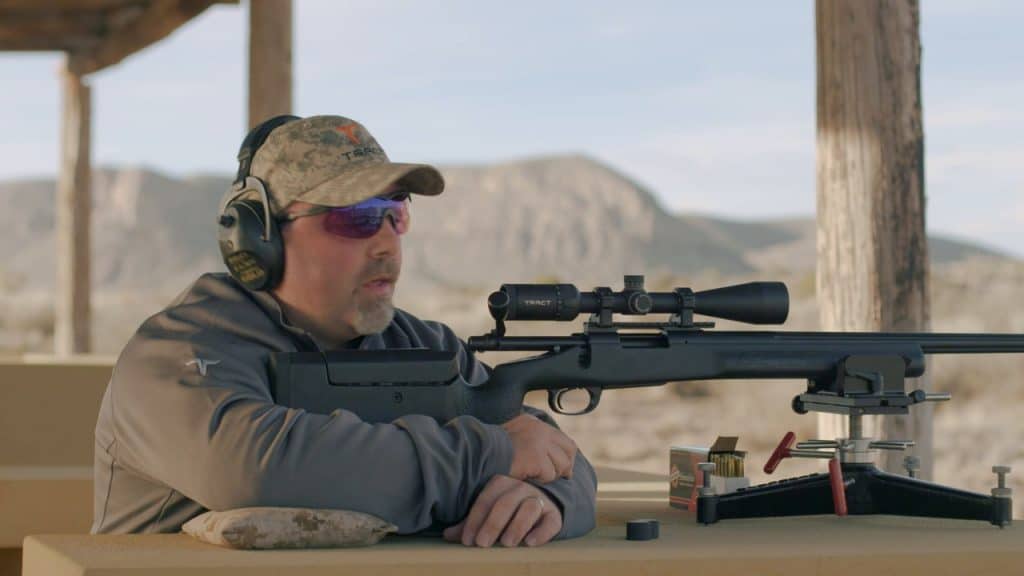So, you want to learn how to sight in your rifle? Is it taking more time and effort than you expected? It takes some know-how to get your scope spot on at 50 yards but the steps we provide below will get you up to speed and help you sight in your scope.
Reducing the amount of time, it takes to sighting your scope in is more time you can be doing something else, like hunting. Once you learn this skill it will become second nature and you will be able to do it every time you need it sighted in.
Let’s begin, how to sight in a rifle scope at 50 yards.
Things You’ll Need to Sight in Your Rifle Scope
Targets – Using a large target will help you determine where the bullet lands easier. A white poster board will work for a target. This enables you to see where the bullet hits even if it’s a way off target. Always use a dependable target for sighting in.
Binoculars and/or Rangefinder – A rangefinder is essential if you really want to dial your shot in. It will ensure, without a doubt, that you have a 50-yard setup. Binoculars will allow you to find where your bullets are landing, and where to adjust.
Ammunition and Gear – Bring good, quality ammunition to shoot through your rifle. Ideally the same ammunition you hunt with. If you use different ammunition to zero your rifle in, then you are using to hunt your trajectory can change and you will not be zeroed in any more.
Laser Boresighter – This will enable you to get your scope into rough alignment the first few times you shoot. These devices are perfect for semi-autos, levers, and pumps because you can’t look down the breech.
Rifle Rest – You want as minimal amount of error as possible when sighting in your rifle. Having a rifle rest is not mandatory, but it is strongly recommended. It takes human error out of the equation and ensures your rifle will be sighted in as close to exact as you can get.
Weather – Good weather is ideal for sighting in a rifle scope. Watch the forecast and pick a good day that has little to no wind. Time of year is important too if you want to avoid the hottest part of the day or to avoid temperatures that will freeze your toes off. Dress accordingly.
This is a small list of items that many hunters and gun enthusiasts will have already. I strongly recommend every item on this list as it will make zeroing your rifle much easier in the long run. Plan a day at the range where you have enough time to sight in your rifle and maybe even have a little fun.
The step by step process below is a proven way to sight in your rifle. If you are new to it exerting patience is important. Take your time and do not rush through anything. There are some proven ways to get your scope zeroed in one shot, but you will not attain the full accuracy of your rifle. If you follow this process, your rifle scope will be as close to zero as any human can get.
How to Sight in Your Rifle Scope at 50 Yards
Step 1) Make Sure Your Scope is Properly Installed
Check that all your components are installed correctly. Your rings and mount should fit properly on your style of rifle. Some scope rings only fit certain scope bases. It is up to you to make sure these components match. Always make safety a first priority. Safety on and unloaded until you are ready to sight it in.
Step 2) Situate Your Scope
Seeing a clear image through your scope is an important step. This also includes adjusting the eye relief, which is the distance between the eyepiece of the scope and your eye. You need to have enough distance between your eye and the end of the scope to ensure that after firing a shot the recoil does not send the scope into your eye. It can cause serious injury and can end the day early.
Step 3) Level Your Rifle
This is where your rifle rest comes in handy. Find a stable, level place to shoot. A mount or tripod will work as well, but you need to make sure it is level to keep your shots on target. A rifle rest or mount is the recommended way to sight in any scope. There is less room for human error this way.
Step 4) Reticle Alignment
Many shooters do not take this part into consideration when zeroing in their rifle scope. Reticle cant refers to your reticle not lining up with windage and elevation. This can be a problem if you are shooting at a target past 200 yards. It will miss to the left or right.
Step 5) Adjusting MOA or Minute Of Angle
The MOA adjustment is usually in ¼ inch increments. This means at 100 yards, to move the bullet one inch you would need to turn the knob through four clicks to make this adjustment. At 50 yards it is 1/8” per MOA click, so each click will give you 1/8 inch of adjustment.
Step 6) Shoot at a Target
Shoot with your target at 50 yards away and fire a cluster of shots at the bullseye. Using 1” grid paper is a good way to measure how much adjustment is needed accurately, and eliminate the guess work. For example; if your shots are 1 inch low and 2 inches to the right, you would turn the top turret 2 clicks clockwise and turn the side turret 4 clicks counterclockwise.
Related: How To sight in your rifle scope at 25 yards
Formulas for Adjustments
Not all scopes have the same adjustment measurement. Some have ¼ inch MOA like described above, while others have 1/8 inch or even ½ inch adjustments. These formulas will make it much easier to zero your rifle in at any range, and eliminate many headaches. If you follow these formulas correctly then you should have no problem zeroing in your rifle scope at any range.
(Distance to target in yards) / (100) = inches per MOA at the distance you are shooting.
(Number of inches of adjustment needed) / (inches per MOA at that distance) = MOA adjustment.
(Number of clicks per 1 MOA on scope) * (MOA adjustment) = adjustment in clicks on your scope.
Related: How To Adjust a Rifle Scope Up and Down
Conclusion
I hope you found this tutorial helpful and you learned how to sight in your rifle scope at 50 yards. Keeping your rifle secure when adjusting your scope. It is highly recommended by myself and many other shooters to use 1” grid paper to easily track how much adjustment is needed. Adjusting your scope will get easier over time as you repeat the process more and more.
If you enjoyed this article you’ll probably like these:



